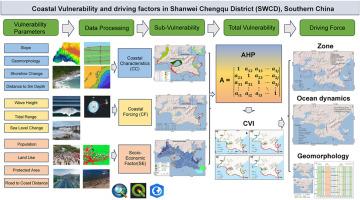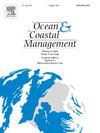汕尾城区沿海脆弱性及其驱动因素分析
IF 5.4
2区 环境科学与生态学
Q1 OCEANOGRAPHY
引用次数: 0
摘要
近几十年来,海岸带的快速发展和转型显著加剧了海岸带的脆弱性,在区域气候变化、环境恶化和全球海平面上升的背景下,海岸带脆弱性面临越来越大的挑战。因此,确定沿海脆弱性的具体驱动因素并通过考虑社会经济条件和自然环境因素来量化脆弱性水平变得越来越重要。本研究采用沿海脆弱性指数(CVI)和层次分析法(AHP)对汕尾城区(SWCD)的脆弱性进行了定量评价,重点考虑了自然影响和人文影响。结果显示,在151.8 km的SWCD大陆海岸线上,脆弱性分布各不相同,其中50%为高度脆弱性,25%为中等脆弱性,其余25%为低脆弱性。主要影响因素包括海岸坡度、地貌、海平面变化、浪高和道路基础设施的存在。该研究强调,在人类活动有限的地区,沿海地区的脆弱性主要由自然环境条件决定。此外,观察到脆弱性的显著空间差异,主要取决于地貌环境和水动力条件的差异。值得注意的是,离SWCD近和远的区域在脆弱性的潜在驱动因素上表现出相似的模式,这表明不同空间背景下可能存在共同机制。然而,由于海岸形态和人类活动强度的不同,空间异质性仍然很明显。本文章由计算机程序翻译,如有差异,请以英文原文为准。

Coastal vulnerability and driving factors in Shanwei Chengqu District (SWCD), Southern China
Over the past few decades, the rapid development and transformation of coastal zones have significantly intensified coastal vulnerability, presenting increasing challenges in the context of regional climate change, environmental degradation, and global sea level rise. Consequently, it has become increasingly critical to identify the specific drivers of coastal vulnerability and to quantify vulnerability levels by taking into account both socio-economic conditions and natural environmental factors. In this study, the Coastal Vulnerability Index (CVI) and the Analytic Hierarchy Process (AHP) were applied to quantitatively assess the vulnerability of the Shanwei Chengqu District (SWCD), focusing on both physical and human-related influences. The results revealed a varied distribution of vulnerability along the 151.8 km mainland coastline of SWCD, with 50 percent classified as highly vulnerable, 25 percent as moderately vulnerable, and the remaining 25 percent as low vulnerability. The key contributing factors included coastal slope, geomorphology, sea level change, wave height, and the presence of road infrastructure. The study highlights that in areas with limited human activity, coastal vulnerability is primarily shaped by natural environmental conditions. Moreover, significant spatial variation in vulnerability was observed, largely determined by differences in geomorphological settings and hydrodynamic conditions. Notably, regions both near and far from SWCD show similar patterns in the underlying drivers of vulnerability, indicating the potential existence of common mechanisms across different spatial contexts. However, spatial heterogeneity remains evident due to site-specific influences such as coastal morphology and the varying intensity of human activities.
求助全文
通过发布文献求助,成功后即可免费获取论文全文。
去求助
来源期刊

Ocean & Coastal Management
环境科学-海洋学
CiteScore
8.50
自引率
15.20%
发文量
321
审稿时长
60 days
期刊介绍:
Ocean & Coastal Management is the leading international journal dedicated to the study of all aspects of ocean and coastal management from the global to local levels.
We publish rigorously peer-reviewed manuscripts from all disciplines, and inter-/trans-disciplinary and co-designed research, but all submissions must make clear the relevance to management and/or governance issues relevant to the sustainable development and conservation of oceans and coasts.
Comparative studies (from sub-national to trans-national cases, and other management / policy arenas) are encouraged, as are studies that critically assess current management practices and governance approaches. Submissions involving robust analysis, development of theory, and improvement of management practice are especially welcome.
 求助内容:
求助内容: 应助结果提醒方式:
应助结果提醒方式:


